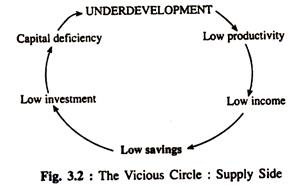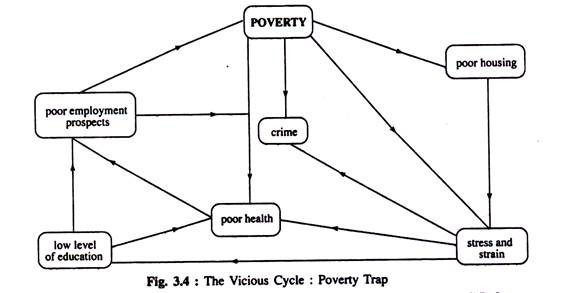Let us make an in-depth study of the vicious circle of poverty and the scarcity of capital.
Many orthodox economists explain the state of underdevelopment in terms of the so-called population explosion in developing countries.
But the relationship between population growth and economic development is complex—it advances development and it retards development. Most economists argue that the poor developing countries suffer from the shortages of physical capital, savings and investment.
This amounts to suggest that economic growth is a function of the ‘capital formation quotient’. Further, there are quite a large number of economists who believe that poverty is the basic cause of underdevelopment. In addition, there are technological gaps in poor developing countries that also explain underdevelopment. Underdeveloped countries are also characterised by many socio-cultural obstacles.
ADVERTISEMENTS:
It is, thus, clear that no single factor can be held responsible for retarding growth and underdevelopment of the poor LDCs. Many of the factors work in tandem and keep these countries in a perpetual state of underdevelopment. To break this deadlock, many economists believe that an increase in capital accumulation is a necessary if not sufficient condition for development.
Before explaining the investment requirements to achieve a growth rate of national income and outlining the various sources of capital formation, we like to understand the notion of vicious circle of poverty. Ragnar Nurkse in the 1950s articulated that poverty of the poor countries may be attributed to the lack of capital formation.
The Vicious Circle Argument:
Capital accumulation is believed to be an escape route from the so-called vicious circle of poverty a circle of low productivity, leading to a small real income and a low saving and capital accumulation leading to low productivity. The source of vicious circle of poverty can thus be traced to low productivity. The crucial issue is how the vicious circle is broken and, ultimately, turned into a ‘virtuous circle’.
ADVERTISEMENTS:
Anyway, continuous and rapid economic growth is a historical abnormality. Therefore, any overall approach to development must take note of the reality, i.e., the various obstacles to growth as well as the persistence of stagnation over a long period of time. The most fashionable concept here is the vicious circle of poverty a concept introduced by Ragnar Nurkse and others. A less developed country is caught in the vicious circle of poverty.
The vicious circle argument holds that conditions in LDCs are such that economic development is impossible. To explain this vicious circle argument, one often uses the notion of a poor man. A poor man, because of very low income, is underfed and under-nourished. Underfeeding as well as under-nourishment makes him weak and becomes susceptible to sickness and diseases. A poor man then earns less as his capacity to earn is also low due to sickness or poor health. Thus, a man is sick because he is poor. Or a man is poor because he is sick.
The implication is clear. It assumes that people of less developed countries save little or nothing since they are poor. Since savings are low, investment is low. Low investment means low productivity levels, and, with low productivity levels, people will always remain poor. Other elements of poverty then appear and become self- reinforcing. For instance, low income is accompanied with poor or low level of education and health. These, in turn, fail to incentivise technological advancement. What is important is that poor countries that are strongly influenced by the vicious cycles can get caught in a poverty trap.
The basic logic of this vicious circle argument is that the greatest obstacle towards the development of an economy is poverty. The primary causes of underdevelopment are so intimately connected that they together form a circle which is vicious. Ragnar Nurkse explains that the vicious circle implies a circular constellation of forces tending to act and react upon one another in such a way as to keep a poor country in a state of poverty. The entire argument is summed up in Nurkse’s words: “A country is poor, because it is poor.” Or “Because it is poor, the country does not develop; because it does not develop, it remains poor.”
ADVERTISEMENTS:
The vicious circle argument is often explained from the supply side and the demand side of capital. The supply of capital is governed by the ability and willingness to save, the demand for capital is governed by the incentives to invest. Nurkse says: “On both sides of the problem of capital formation in poor countries a vicious circle exists.”
Let us first explain the supply side of capital. A poor country saves little because of poor income. As a result, it experiences shortage of capital for developmental activities. Lack of capital supports the labour-intensive technique of production. This technique of production is less productive. In other words, a poor country experiences low productivity. And low income is the result of low productivity.
The supply side has been aptly summarised by P. A. Samuelson:
“They (the under- developed countries) cannot get their heads above water because their production is so low that they can spare nothing for capital formation by which their standard of living can be raised.” This sort of vicious circle may be represented diagrammatically (Fig. 3.2).
Now, from the demand side of capital, one can explain the vicious circle argument. The logic is: In a poor country, demand for capital is less because of low investment which is the result of low purchasing power of masses. In other words, low income means limited market opportunities. Low purchasing power or limited market for goods tells on investment which becomes low. Low investment now spells low income. Thus, underdevelopment perpetuates and the poor country is caught in low income equilibrium. The low level of income is a point that is common to both the circles. This is shown in Fig. 3.3.
It is thus clear that poverty is the cause of poverty and the entire logic is cumulative. In other words, poor countries are held down to their low levels of per capita incomes by “interlocking vicious circles”. Self-perpetuating poverty and deprivation get transmitted from one generation to the next in a poor country. Because of poor income of poor people, children start school at a disadvantage and may receive little support from their parents.
With little qualifications they cannot get decent jobs and good wages. Thus, they remain poor. “They will probably pass on to their children this inheritance of low wages, poor housing, ignorance and perhaps violence. Poverty is seen in these terms as the result of particular qualities of those in poverty, without reference to the social institutions of political structure under which it exists.”
Interlocking vicious cycles may be presented in another way (see Fig. 3.4).


